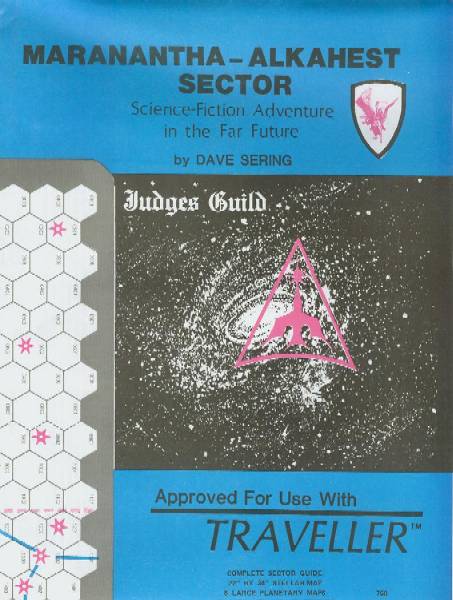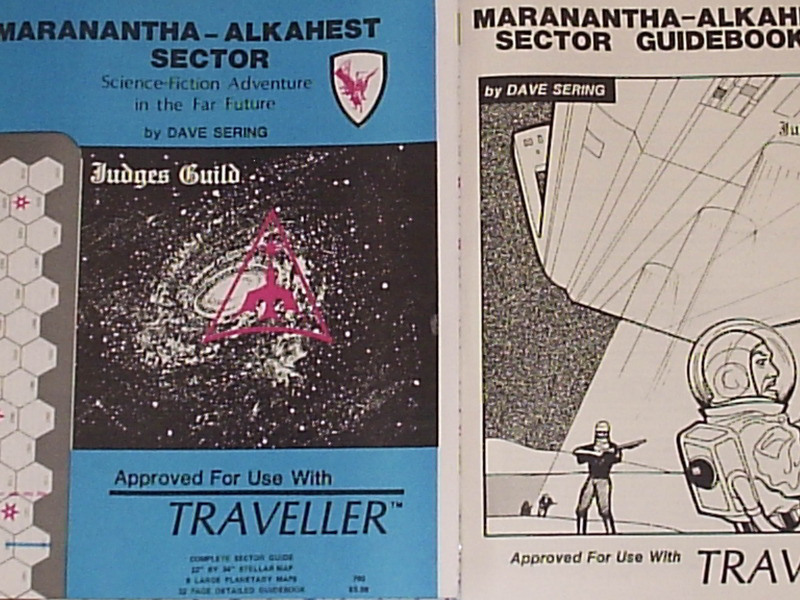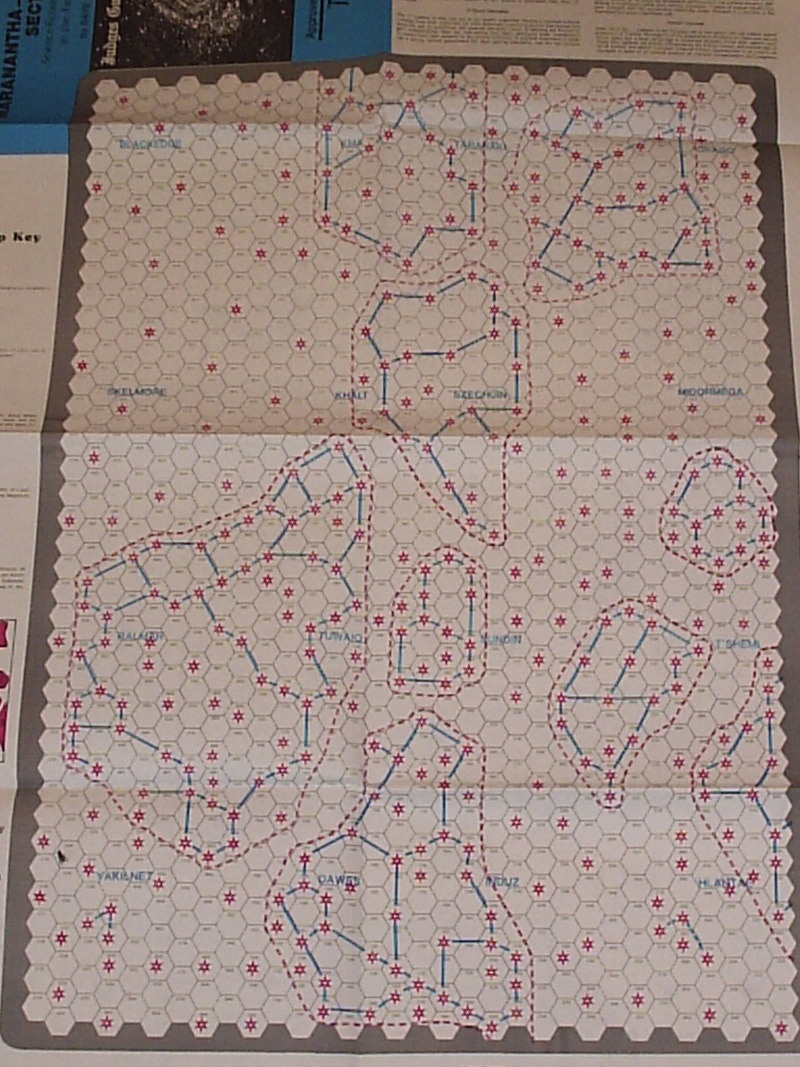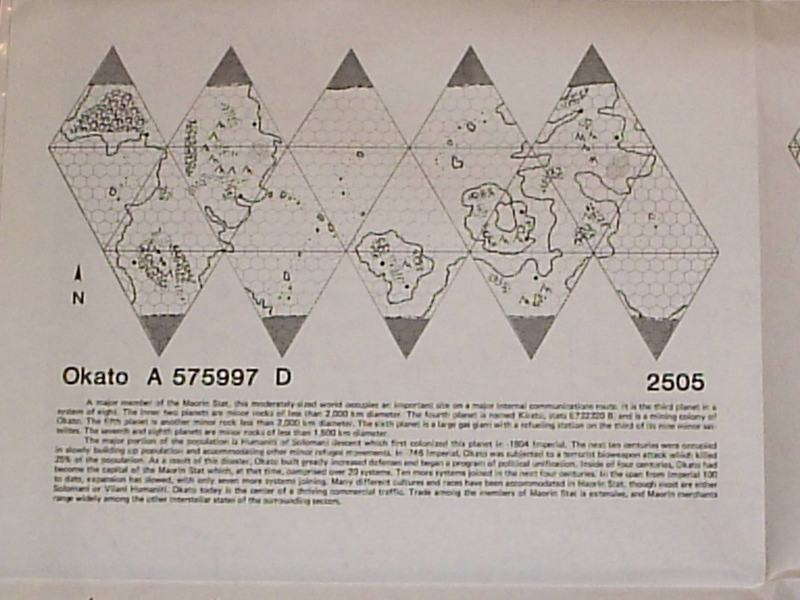Maranatha-Alkahest Sector
This review originally appeared on the author’s Wordpress blog in July 2015, and is reprinted here and in the August 2015 issue with permission.
 Maranatha-Alkahest
Sector. Dave Sering.
Maranatha-Alkahest
Sector. Dave Sering.
Originally by Judges Guild http://www.judgesguild.org
Currently from FarFuture Enterprises http://www.farfuture.net
24pp, PDF
US$6.70/UKú4.32
This supplement is pretty danged cool. Now, the production values are not on par with the classic Traveller LBB’s. The paper is the sort of thing you’d give to elementary school students to do their classwork on. The subsector maps just don’t have quite the verve of the ones that GDW put out. And yeah, the addition of an extra color on the world maps really gave the GDW world maps a lot of extra kick that you don’t see here. Nevertheless, this thing is uber cool.
 I’m
not even sure how they pulled this off, though. I mean, anyone could
roll up a sector map, sure. And anyone could go back over the results to
clean them up a little. But these guys… they crafted this sector right
between four major empires… but they did it without the Alien Modules.
K’kree (1984), Solomani (1986), and Hivers (1986) are all referenced
here. Everything is consistent with later canon. In fact… the outline of
each of the nine interstellar polities presented here survive onto the
map presented in GURPS Traveller Second Edition.
I’m
not even sure how they pulled this off, though. I mean, anyone could
roll up a sector map, sure. And anyone could go back over the results to
clean them up a little. But these guys… they crafted this sector right
between four major empires… but they did it without the Alien Modules.
K’kree (1984), Solomani (1986), and Hivers (1986) are all referenced
here. Everything is consistent with later canon. In fact… the outline of
each of the nine interstellar polities presented here survive onto the
map presented in GURPS Traveller Second Edition.
The thing I like about this product is that there’s really nothing much you can do with it except start playing. That’s genius, really. With GURPS Rim of Fire, for instance, I will read it cover to cover, then go back and pick a subsector and reread it a few times, then pick out a world to start a campaign on, then fret about the worlds that aren’t detailed, then get distracted by something else and never really start a game. But that’s just not how you run a game with the original Books 1-3. The whole idea of this product is that the players will be travelling through this sector, meeting up with random patrons, and (probably) mucking around with the trade rules. From there, who knows what will happen?!
I really like the system for the random charts presented here, though. There is a 3d6 table for rumors… but on a 15, you check a d6 table for a given polity. Events differ from rumors in that they can occur only once. One third of the events are (again) from a d6 table for each polity… the remaining twelve are generic. If you get the same event twice, you either reroll or else check the local event chart.
 This
is what makes it possible for you to start using this product right away
without doing a big research project. The entire sector has a certain
baseline tone… and each polity has its own character. You get the
benefit of both types of local color without having to internalize
details about the entire map. And as each event occurs, the precise
world where it gets placed will gain a new factor that can color the way
you interpret future actions that occur there. The referee that put all
this together gives you something that’s more “just in time” campaign
design rather than some sort of artisanal masterwork that you can’t ever
truly master.
This
is what makes it possible for you to start using this product right away
without doing a big research project. The entire sector has a certain
baseline tone… and each polity has its own character. You get the
benefit of both types of local color without having to internalize
details about the entire map. And as each event occurs, the precise
world where it gets placed will gain a new factor that can color the way
you interpret future actions that occur there. The referee that put all
this together gives you something that’s more “just in time” campaign
design rather than some sort of artisanal masterwork that you can’t ever
truly master.
 Eight
of the worlds get a complete planetary map. The UWP data is in Book 3
format rather than Book 6 (1983), of course. It’s interesting to see the
trade classifications spelled out. And the black hole on the Blackedge
subsector is just plain wild! (it’s marked as a Navigational Hazard
right on the subsector map.) Other oddities are frequent use of
attribute checks and lots of aliens and alien creatures.
Eight
of the worlds get a complete planetary map. The UWP data is in Book 3
format rather than Book 6 (1983), of course. It’s interesting to see the
trade classifications spelled out. And the black hole on the Blackedge
subsector is just plain wild! (it’s marked as a Navigational Hazard
right on the subsector map.) Other oddities are frequent use of
attribute checks and lots of aliens and alien creatures.
It’s possible that that this thing has something wonky going on with the data– it’s hard to trust anybody to produce sane UWP data, really. But I gotta say, this is a really neat supplement, especially with a physical product. It’s basically great big sector map that you can just hand to the players like its a road atlas or something; you just don’t see that very often. (I know squinting at the compilation of subsector maps in the back of GURPS Rim of Fire was just plain painful. Bah!) I don’t know why this isn’t normal for the game. Sure, you can’t cram something like this into either an LBB or a perfect bound book. Nevertheless, you’d think someone would have figured something out about this in the past couple decades! In this respect, Judges Guild is still at the cutting edge of space gaming.
 Freelance
Traveller
Freelance
Traveller